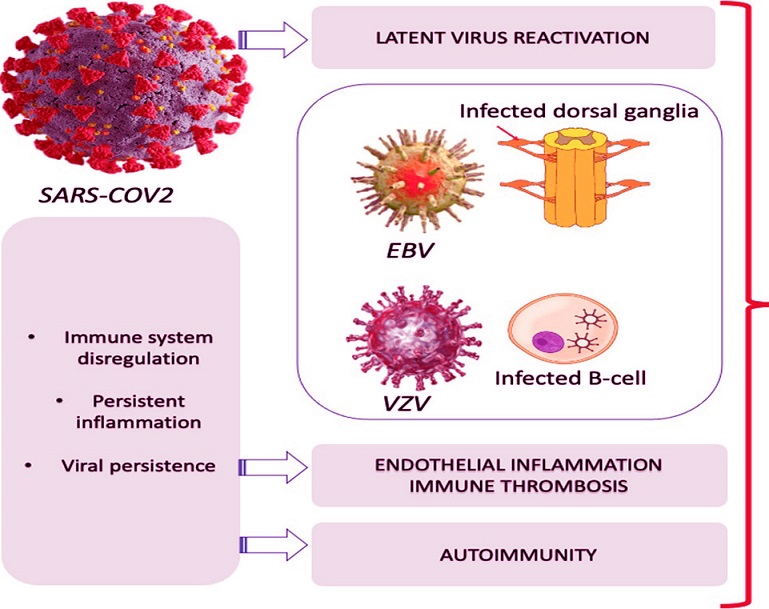Italian scientists claim that reactivated latent infections are the cause of Long COVID symptoms
Nikhil Prasad Fact checked by:Thailand Medical News Team Nov 26, 2024 11 months, 1 week, 2 days, 22 hours, 18 minutes ago
Medical News: Long COVID, or post-acute sequelae of SARS-CoV-2 infection (PASC), continues to affect millions worldwide, leaving researchers puzzled over its root causes. Persistent symptoms such as fatigue, brain fog, and respiratory problems linger for months after the acute phase of COVID-19. While much remains unknown, a groundbreaking review sheds light on the potential role of reactivated latent infections, adding a critical dimension to understanding this debilitating condition.

A team of Italian researchers from the Università “Magna Graecia” and Azienda Ospedaliero Universitaria Renato Dulbecco conducted an in-depth analysis of available literature to explore whether viruses like Epstein-Barr virus (EBV), cytomegalovirus (CMV), and varicella-zoster virus (VZV) are significant contributors to Long COVID. This
Medical News report delves into their findings, unraveling the complex interplay between latent infections and Long COVID.
What Are Latent Infections?
Latent infections are caused by viruses that remain dormant in the body for years, reactivating under specific conditions such as weakened immunity or other infections. Examples include herpesviruses like EBV, CMV, and VZV. Researchers hypothesize that the immune dysregulation triggered by SARS-CoV-2 may prompt the reactivation of these latent infections, creating a cascade of chronic inflammation and cellular damage.
This study examines the connection between latent infections and Long COVID, suggesting they might not only exacerbate symptoms but also be central to the prolonged illness.
Key Study Findings
The role of latent viruses in Long COVID is a major focus of the study. The researchers highlight how reactivation of these viruses could amplify the inflammatory state initiated by SARS-CoV-2. EBV, for instance, is known to cause fatigue, cognitive dysfunction, and general malaise - symptoms remarkably similar to those observed in Long COVID. CMV and VZV reactivation were also noted to impact the neurocognitive and immune landscape of affected individuals.
-EBV: Approximately 90% of people harbor EBV in a latent state. SARS-CoV-2 may trigger its reactivation, leading to worsened fatigue and neurological symptoms. The review emphasizes a significant association between EBV antibodies and prolonged symptoms in Long COVID patients.
-CMV: Interestingly, CMV reactivation might act as a protective factor against certain Long COVID symptoms, such as neurocognitive dysfunction, by modulating inflammatory pathways.
-VZV: Reactivated VZV, responsible for conditions like shingles, was linked to neuropathic symptoms and vesicular rashes in Long COVID patients.
The study also highlighted the role of immune dysregulation in Long COVID. SARS-CoV-2 appears to trigger a prolonged inflammatory state, depleting immune cells and damaging tissues. This immune dysfunction allows latent viruses to reemerge, potentially causing overlapping symptoms that blur the lines between Long COVID
and viral reactivation syndromes.
In addition to immune dysfunction, the researchers found evidence of endothelial damage and immune thrombosis, which are associated with symptoms like breathlessness, fatigue, and brain fog. Markers such as von Willebrand factor (vWF) were elevated in many patients, reinforcing this link.
Viral Persistence of SARS-CoV-2
Persistent viral reservoirs of SARS-CoV-2 itself may also contribute. Studies have suggested that the virus lingers in immune-protected areas such as the lungs and intestines, potentially driving chronic inflammation and facilitating latent virus reactivation.
Implications for Diagnosis and Treatment
The findings point to several promising avenues for improving the diagnosis and treatment of Long COVID.
Early detection of latent virus reactivation could be crucial. Serological tests that identify markers of reactivation, such as EBV and CMV antibodies, may help pinpoint patients at risk of severe Long COVID symptoms and guide targeted interventions.
Antiviral therapies could play a key role. While antivirals like acyclovir have demonstrated effectiveness against EBV and VZV in laboratory settings, their real-world efficacy in managing Long COVID remains uncertain. The study calls for urgent clinical trials to evaluate these therapies in the context of Long COVID.
Conclusion
This study underscores the complex nature of Long COVID, with latent viral reactivations emerging as a critical factor in its persistence and severity. These findings open the door to new diagnostic and therapeutic strategies, offering hope to millions suffering from the long-term effects of the pandemic. By focusing on the interplay between SARS-CoV-2 and latent infections, researchers aim to better understand and ultimately manage this debilitating condition.
The study findings were published in the peer-reviewed Journal of Clinical Medicine.
https://www.mdpi.com/2077-0383/13/23/7124
For the latest Long COVID News, keep on logging to Thailand
Medical News.
Read Also:
https://www.thailandmedical.news/news/long-covid-and-the-hidden-changes-in-red-blood-cells
https://www.thailandmedical.news/news/olive-oil-and-mediterranean-diet-offer-hope-for-long-covid-recovery
https://www.thailandmedical.news/articles/long-covid
